
Country superstar, and Grammy Award-winner Tim McGraw took to the road late last spring for a 17-city amphitheater tour, aptly titled McGraw Tour 2022. The show featured a set list packed with McGraw’s hits from his 30-plus years’ career. Since 2012, Lighting and Production Designer Patrick Brannon has designed five of McGraw’s tours, handling both the stage environment and lighting for the performances, including for this recent outing. Nashville-based Premier Global Production Co. provided the lighting support for Brannon’s designs, and were also back for McGraw Tour 2022. Steven “Creech” Anderson—who goes back with Brannon to their days at Light and Sound Design, when Brannon was building a Bon Jovi tour and Creech was building a Scorpions tour—is today the Senior Accounts Manager for PGP and Brannon’s contact at the shop. Another long-time colleague of Brannon’s, Troy Eckerman, programmed the lighting on a grandMA3 console running MA2 software. Busy designing the upcoming 2023 McGraw tour, Brannon took some time to tell PLSN about how the 2022 plan evolved from a pared-back bigger design from the cancelled 2020 tour. He also shares some of the new things he really likes having in his design toolbox.
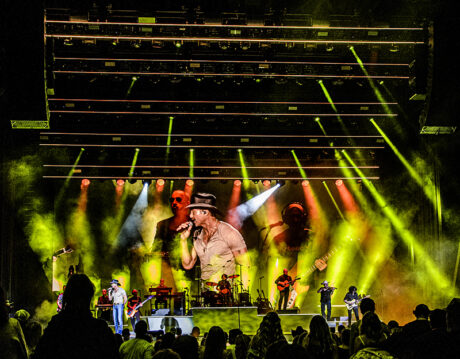
How did your design evoke visually what Tim McGraw wanted to bring to the audience?
For this tour, I took the theme of neon. Back in 2019, Tim released an album called Neon Church and everything—all the graphics and advertisements—had a bit of a neon theme. So, I went with that. I had a neon-like product surrounding all the edges of the trusses, and a lot of the video content consisted of some neon looks as well. We had a big design in place, a 16-truck tour for 2020, but then with Covid, that meant we had to put everything on hold. This last year was the first time we had an opportunity to go out and do something with that plan. But of course, with it being the first year back, everybody was a little apprehensive of a tour that big. I needed to reduce it to six trucks, mainly because they weren’t sure about the availability of personnel to put it all up as originally designed. It ended up being exactly six trucks and everything went very well. When you do a big design, and you put a lot of time into the planning of something like that, it’s always a little disappointing when you don’t get to go out with all the toys in the toy box. But it all turned out, in fact—lighting fixture-wise—I didn’t really lose that many lights, but the motion was cut, and the video surfaces were reduced; it was all a little smaller than we had hoped. It still looked really good though, and everybody was happy.
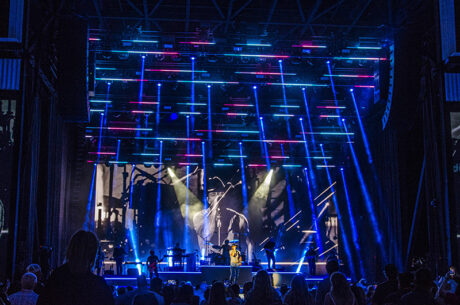
What was the product you used to get the neon look?
We used a product called Edgelight, which is a part of Go Live Productions, out of Nashville, TN. I really liked using it and was very satisfied with that product. I had over 1,300’ of it on this tour, between double runs on all the trusses and edging the 32’ x 32’ thrust and risers. It was seamless, and we had absolutely zero problems with it; which is very unusual for something you’ve never used before. It looked amazing and I’ll likely be using it again in the near future. It is like a sealed rope light, it is RGB and it has an IP65 rating, which is important when doing sheds, there’s a lot of moisture involved. The cool factor about the product is that all the fixtures were dumb. If you lost some LEDs, or a section wasn’t talking to the system, all you had to do was put another one in there and the brain automatically recognized it and it carried on. We worked with Scott Moore from Edgelight, who did a great job. The guys that put it all together with us did a fantastic job on packaging. They’re very hands-on and came out and got everything going and showed the crew what they needed to look for. It is always a great experience when you get to have a new product on the table for consideration and it works out so well.
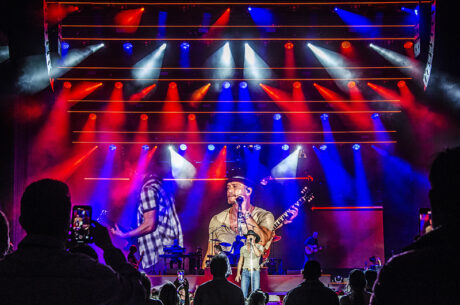
What were some other key pieces of gear for this tour?
PGP, my lighting vendor, always takes great care of me, and Steve Anderson—Creech—hooked me up with the people from Claypaky, including George Masek. Claypaky really came to bat for me on this one. They demoed the laser sourced XTYLOS fixtures for Creech and me at PGP and then were able to get me some in time for the tour. I really liked using those units and in fact, I’ve implemented more in the design for the tour coming up this year. They’re super, super bright, the color saturation is perfect, and the laser source is really cool. I had no problems with them. Seventeen consecutive shows for a light that’s still new, still cutting its teeth, and we didn’t have a single issue. The XTYLOS were used on pretty much every song, sometimes in conjunction with the graphics on the video screen. I had 12 of them on the floor upstage, behind the band and below the video screen. I needed more horsepower on the floor, and the XTYLOS units gave it to me. Their color mixing was fabulous, pan and tilt smooth, and the auto-dimming feature was very useful. They produced a really cool beam of light that was solid and full. They have a certain number of rotating gobos and can mimic a cone laser—you wouldn’t believe how close the effects of that light come to looking like a laser. I’m always looking for new products and I like to stay green and these were great.
You also had a number of Claypaky A.leda B-EYE K20 and Sharpys in your rig.
I’m a big Claypaky fan. The K20s were super bright with an amazing color palette and fullness of color and the ability to go full flood or down to a pretty sharp narrow beam. They were mounted overhead in the truss to wash the stage and the audience. The Sharpy has been my workhorse for years and years, and I had 30 Sharpys in the truss and six more on the floor. Sharpys are my go-to special effects beam fixture. They’re super-fast; you can’t beat their speed. I like their prism, gobo effects, and the tube effect with a pin spot. All of the fixtures in my rig performed well and didn’t give us any problems.
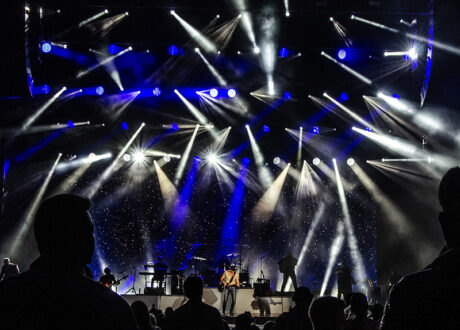
Let’s talk about challenges and solutions on this tour.
The only challenge I had was keeping the same theme that I did in 2020 pre-Covid. I kept the same fixtures in the original design but the original design had motion and video layers above the stage that all went away. Anytime you have motion it’s going to add a lot of truck space to carry it. In the original design, with motion, I had the trusses for the grid running up and downstage. For this reduced-sized tour, I flipped the truss sideways, stage left to right. I loaded the trusses in the same configuration when you looked at it in plan view, I just put the same lights in the same positions on the now horizontal trusses. It all worked perfectly. Also, I was trying to keep the same neon theme, with the fixtures and the neon look, which I actually think I pulled off pretty well. I laced the Edgelight product onto the risers and the thrust stage. The risers and staging were supplied by Gallagher Staging out of Nashville.
I thought that overall, when the house lights went out, I had the same theme; the same image that I had in my head, it just didn’t have any motion.
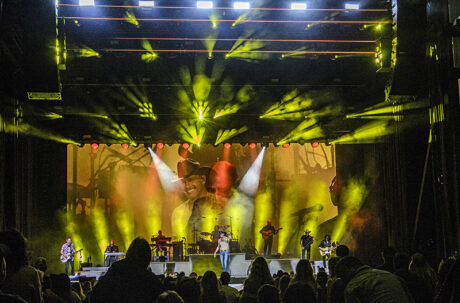
Tell us about your use of video for the McGraw Tour 2022.
We used ROE Visual CB5 panels for our main I-Mag screen, which in my opinion, you can’t beat ROE Visual products. I cut the video panels off the front of the risers, which I had originally designed. We did have a huge screen upstage center that was like 50’ x 26’. Fuse was the vendor, and they did an excellent job—great crew and great product. It look really good.
What’s something you’d hope another lighting person might notice in the design?
I would hope that they would notice the rock looks that I try to create in a country fashion. And then with the neon concept, getting that into the design, I think worked well. So from a lighting perspective, I hope they might see that and think “well, he did pull that off with limited gear.”
In your career in general, how would you describe your approach to design?
I like to just look at things with a gut feeling and I like to talk to the artists to get an idea of what they’re looking for. Some artists want pretty; sometimes they want big rock looks. I try to combine all those ideas in any design. I also like to keep things mysterious and theatrical. As far as lighting goes, there’s a couple songs that I’ve never frontlit Tim for at all; it was all backlit. So, it gives a little mystery to the video screens and video surfaces when you don’t really show the artist’s face. It’s something that’s always intrigued me. It goes back to my theater roots. I try to incorporate different things I’ve learned in the last 40 years to every new design.
Any final thoughts about designing for Tim McGraw?
Tim’s a great artist to work with. He knows what he wants and he actually makes my job a little easier because he is vocal about his wants. We have a really fantastic work relationship. I seem to cover the canvas that he sees in his head. So, so far so good; knock on wood! It’s really a pleasure working with the whole team; it’s a great group to be a part of and that comes from Tim really wanting the most out of what he gives his fans at that two hour show.
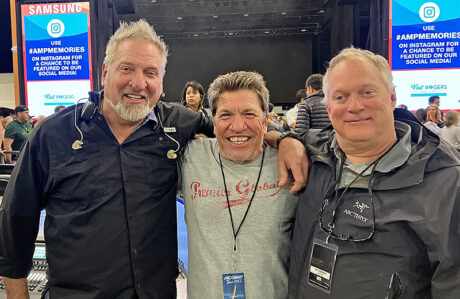
Production Team
- Tour Manager: Mike McGrath
- Production Manager: Tim Shanahan
- Lighting Designer/Director: Pat Brannon
- Lighting Programmer: Troy Eckerman
- Stage Manager: Matt Monahan
- Rigger: Danny Machado
- Lighting Crew Chief: Colin Craig
- Lighting Technicians: Hunter Partridge, John Finley, Bryan Petyan, Ryken Salamy
Vendors
- Lighting: Premier Global Production / Steven “Creech” Anderson
- LED Neon: Edgelight, a Division of Go Live Productions / Scott Moore
- Video: Fuse Technical Group
- Staging: Gallagher Staging
Gear
Lighting
- 2 MA Lighting grandMA3 Console
- 1 Custom Data Rack
- 12 Claypaky XTYLOS
- 36 Claypaky A.leda B-EYE K20
- 36 Claypaky Sharpy
- 27 GLP JDC1 Strobe
- 6 GLP impression X4
- 49 Martin MAC Axiom
- 8 SGM P-10 Strobe
- 2 Robe BMFL Wash
- 2 Robe RoboSpot Followspot System
- 1,300’ Edgelight, RGB
- 7 Prop Power 48-Way 208V Power Distro
- 25 10’ Tyler Truss GT Truss, Black
- 5 8’ x 20” Utility Truss, Black
- 6 10’ x 12” Utility Truss, Black
- 35 1-Ton Hoist
- 4 hazebase Base Hazer
- 2 High End Systems FQ-100 performance fog generator
- 2 Low Fog Machine
- 4 Fans


